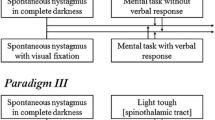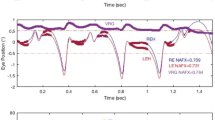Summary
The spatial and temporal characteristics of optokinetic nystagmus (OKN) were investigated in the alert rhesus monkey under open and closed-loop conditions. One eye of each animal was immobilized by transection of the 3rd, 4th and 6th nerve intracranially. On optokinetic stimulation of the paralytic eye (open-loop) with the monkey's head restrained, eye movement records of the occluded, moving eye demonstrate a gradually increasing OKN, its slow phase reaching angular velocities much faster than pattern speed. This runaway effect is discussed in terms of the “corollary discharge” concept. Similarities of optokinetic and post-rotatory vestibular after-nystagmus are discussed. Investigation of the spatial parameters shows that the size of perifoveal areas successfully stimulated to elicit optokinetic nystagmus is relatively small under open-loop conditions and that this size depends on the distance of the stimulated area from the fovea, the minimum field diameter being an exponential function of excentricity. The preparation is shown to be useful for objective measurements of visual functions in the experimental monkey.
Deutsche Zusammenfassung
An wachen Affen wurden räumliche und zeitliche Parameter des optokinetischen Nystagmus (OKN) im offenen und geschlossenen Regelkreis untersucht. Ein Auge jedes Affen wurde durch Hirnnervendurchtrennung immohilisiert. Bei optokinetischer Reizung dieses Auges wurde bei fixiertem Kopf am abgedeckten, frei beweglichen Auge ein ständig zunehmender OKN registriert, dessen langsame Phasengeschwindigkeit die Reizmustergeschwindigkeit vielfach überstieg. Dieser Effekt wird im Zusammenhang mit dem Reafferenzprinzip diskutiert. Die Ähnlichkeiten zwischen optokinetischem und postrotatorischvestibulärem Nach-Nystagmus mit periodischem Richtungswechsel werden besprochen. Im offenen Regelkreis ergeben auch kleine optokinetische Reizfelder deutliche Bewegungseffekte. Der Schwellen-Durchmesser der Reizfelder ist eine Exponential-Funktion der Exzentrizität. Die Versuchsanordnung eignet sichzur objektiven Bestimmung visuell-sensorischer Funktionen.
Similar content being viewed by others
References
Aschan, G., Bergstedt, M.: The genesis of secondary nystagmus induced by vestibular stimuli. Acta Soc. Med. upsalien.60, 113 (1955).
Bond, H.W., Ho, P.: Solid miniature silver-silver chloride electrodes for chronic implanatation. Electroenceph. clin. Neurophysiol.28, 206–208 (1970).
Collewijn, H.: Optokinetic eye movements in the rabbit: input-output relations. Vision Res.9, 117–132 (1969).
Evarts, E.V.: Methods for recording activity of individual neurons in moving animals. In: R.F. Rushmer (Ed.) Methods in Medical Research, pp. 241–250. Chicago: Year Book Medical Publisher 1966.
Helmholtz, H.v.: Handbuch der Physiologischen Optik. Leipzig: Voss 1867.
Holst, E.v., Mittelstaedt, H.: Das Reafferenzprinzip. (Wechselwirkungen zwischen Zentralnervensystem und Peripherie). Naturwissenschaften10, 464–476 (1950).
Jung, R.: Optisch-vestibuläre Regulation der Augenbewegungen, des Bewegungssehens und der Vertikal-Horizontal-Wahrnehmung: ein Beitrag zur optisch-vestibulären, optischokulomotorischen und optisch-gravizeptorischen Integration. In: Brain and Mind Problems, pp. 185–226. Rome: Il Pensiero Scientifico 1968.
Koerner, F., Dichgans, J.: Bewegungswahrnehmung, optokinetischer Nystagmus und retinale Bildwanderung. Albrecht v. Graefes Arch. Min. exp. Ophthal.174, 34–48 (1967).
Kornhuber, H.H.: Optokinetischer Nach-Nystagmus, vestibuläre Übererregbarkeit und periodischer Nystagmus. Klin. Wschr.40, 549 (1962).
Kornmüller, A.E.: Eine experimentelle Anästhesie der äußeren Augenmuskeln am Menschen und ihre Auswirkungen. J. Psychol. Neurol. (Lpz.)41, 354–366 (1931).
Mackensen, G., Wiegmann, O.: Untersuchungen zur Physiologie des optokinetischen Nachnystagmus. I. Mitt. Albrecht v. Graefes Arch. klin. exp. Ophthal.160, 497–509 (1959).
Narazaki, Gutmann, Kornhuber: unpublished. (Cited in: J. Berendeset al., Ed.: Hals-NasenOhren-Heilkunde. Ein kurzgefaßtes Handbuch, Bd. III. Stuttgart: Thieme 1966, 2227).
Ohm, J.: Ist der optische Drehnystagmus von einem unbeweglichen Auge auslösbar ? Klin. Mbl. Augenheilk.21, 330–336 (1926).
Pasik, T., Pasik, P., Bender, M.B.: Optokinetic nystagmus upon stimulation of an akinetic eye in the monkey. Confia, neurol. (Basel)21, 109–118 (1961).
Schiller, P.H.: The discharge characteristics of single units in the oculomotor and abducens nuclei of the unanesthetized monkey. Exp. Brain Res.10, 347–362 (1970).
—, Koerner, F.: Discharge characteristics of single units in superior colliculus of the alert rhesus monkey. J. Neurophysiol.34, 920–936 (1971).
Sperry, R.W.: Neural basis of the spontaneous optokinetic response produced by visual inversion. J. comp. physiol. Psychol.43, 482 (1950).
Ter Braak, J.W.G.: Untersuchungen über optokinetischen Nystagmus. Arch, neerl. Physiol.21, 308–376 (1936).
Teuber, H.-L.: Perception. In: J. Fieldet al. (Ed.): Handbook of Physiology, Section 1, Neurophysiology, 3, 1595–1688, Washington, Amer. Physiol. Society, 1960.
Author information
Authors and Affiliations
Additional information
This research was supported in part by NSF Grant GB-17047, Foundation Fund of Research in Psychiatry Grant G 69-447 and NASA Grant NGL 22-009-308.
Rights and permissions
About this article
Cite this article
Koerner, F., Schiller, P.H. The optokinetic response under open and closed loop conditions in the monkey. Exp Brain Res 14, 318–330 (1972). https://doi.org/10.1007/BF00816166
Received:
Issue Date:
DOI: https://doi.org/10.1007/BF00816166




